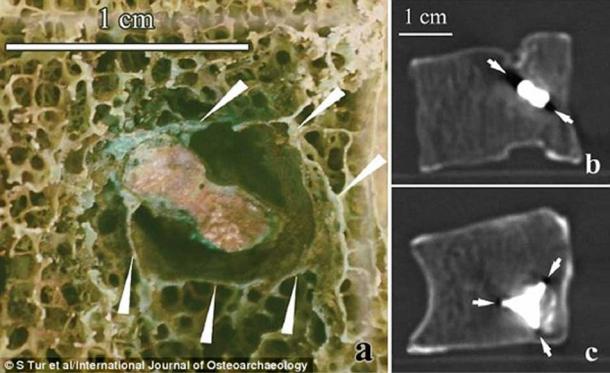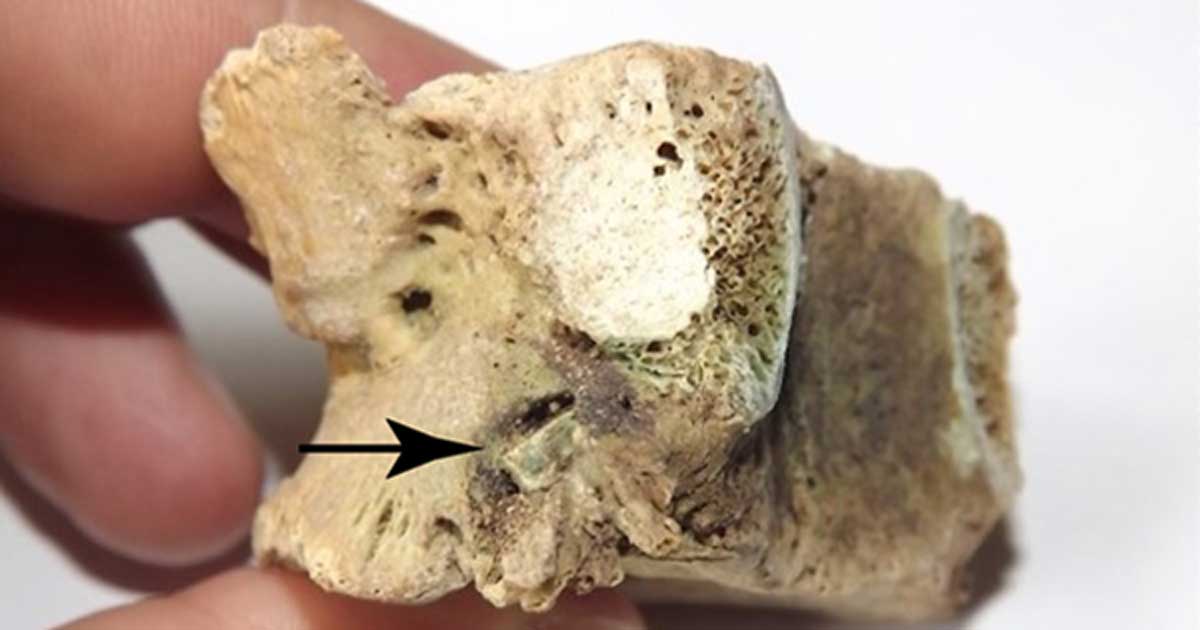The Warrior Who Survived with an Arrow Embedded in His Spine
In 2015, it was reported that a bronze arrowhead was discovered to have been lodged in the spine of a warrior. Whilst an injury like this would have normally been fatal, it seems that this ancient warrior survived for a couple of months, if not years, with the projectile stuck in his back. The vertebra and the bronze arrow were studied in order to gain a better understanding of what had happened, and the results of the study were published in the International Journal of Osteoarchaeology.
In 2011, a kurgan (a burial mound) in the Koitas cemetery in Central Kazakhstan was excavated. The kurgan had already been completely looted in the past, and the archaeologists were only able to find several pieces of disarticulated human bones, i.e. a vertebra, as well as several ribs and fibulae. Based on the burial mound’s constructive and stratigraphic features, it was suggested that this structure belonged to an aristocrat or elite of the Saka society.

Scythian warriors, drawn after figures on an electrum cup from the Kul'Oba kurgan burial near Kerch. (Public Domain)
The Saka (known also as the Scythians, Scyths, and Sacae) was the name given to the nomads of the Central Asian steppes. Today, the Saka are known to have existed from as early as the 9 th century BC, which corresponds to the Iron Age in Europe. Up until the 20 th century, however, much of what was known about the Saka came from the writings of the ancient Greek historian Herodotus.
- A Warrior’s Face Frozen in Time, Gold, Hemp, Tents and Cheese Tell the Scythian Tale
- Reconstruction of Golden Woman, the ancient Scythian Princess of Kazakhstan
- Scythian Tactics and Strategy: Devastating Guerilla Archers - Part I

Scythian (or Saka) Warrior with Axe, Bow, and Spear (CC BY-SA 3.0)
Herodotus provides his readers with much information about these nomads. For instance, the ancient historian describes the different tribes of Saka, such as the Orthocorybantians (meaning ‘pointed hat men’, and referred to by the Persians as the Sakâ tigrakhaudâ, which means ‘Saka with pointed hats’), the Massagetes (which in Persian would have been something like Mâh-Sakâ, meaning ‘Moon Saka’), and the Pausikoi, which the Persians called Apâ Sakâ (meaning ‘Water Saka’). Herodotus also wrote extensively about the Saka way of life, and their customs. Apart from Herodotus, the Saka were also mentioned, albeit to a much lesser extent, in Persian documents. It was only with archaeological excavations that we know more today about the Saka.

CT images showing the cavity produced by the arrow head and the healing of the bone around it. (Image: International Journal of Osteoarchaeology)
Returning to the excavation of the kurgan in the Koitas cemetery, the bones discovered provided the archaeologists with some idea of what the individual was like. It was determined, for example, that the bones belonged to a man between 25 and 45 years old, and was about 174 cm in height. The most intriguing fragment, however, was the vertebra. With the naked eye, the tip and the end of an arrowhead can be seen penetrating the bone. Using computed radiography, it was found that the arrow pierced the bone from above from the right to the left. Computed tomography scans also revealed the shape of the arrowhead, and allowed researchers to conclude that it was of a military form. Additionally, X-Ray Fluorescence Spectrometry revealed that the arrowhead was made of a copper alloy with a high tin content, or bronze.
- Secret Chamber Found at Scythian Burial Mound Reveals Golden Treasure of Drug-Fueled Rituals
- The Royal Kurgan of Kerch: The Burial Mound Built by a King
- Elite Iron Age Scythian warrior discovered with bronze arrowhead embedded in his spine


The arrow pierced the bone from above from the right to the left (Image: International Journal of Osteoarchaeology)
Generally speaking, such injuries to the spine would have been fatal, and a person on the receiving end of such a blow would have died shortly after. In the case of this Saka warrior, however, it seems that he went on living for several months, if not years, with the arrowhead embedded in his spine. This is evident based on the fact that there is new bony formation at both ends of the arrowhead, which is an indication that the individual survived long enough for the healing process to take place.
It has been pointed out that an arrow to the spine could result in a number of scenarios that would have led to a person’s death. In other words, the Saka warrior from the Koitas cemetery had been very fortunate to survive. Such cases, however, are rare, and not many examples are available in the current corpus of bioarchaeological literature.
Top image: The vertebra of the warrior with an arrowhead embedded in it. Image source: Svetlana Svyatko.
By Wu Mingren
References
Geggel, L., 2015. Iron Age Warrior Lived with Arrowhead in Spine. [Online]
Available at: https://www.livescience.com/51360-iron-age-warrior-survived-arrowhead.html
Gill, N. S., 2016. Scythians in the Ancient World. [Online]
Available at: https://www.thoughtco.com/scythians-in-the-ancient-world-116905
Gray, R., 2015. Arrowhead discovered lodged in Iron Age warrior's spine... and scans reveal he SURVIVED the injury. [Online]
Available at: http://www.dailymail.co.uk/sciencetech/article-3144929/Arrowhead-discovered-lodged-Iron-Age-warrior-s-spine-scans-reveal-SURVIVED-injury.html
Killgrove, K., 2015. Bronze Arrowhead Embedded In Spine Shows Elite Iron Age Warrior Survived Battle. [Online]
Available at: https://www.forbes.com/sites/kristinakillgrove/2015/06/08/bronze-arrowhead-embedded-in-spine-shows-elite-iron-age-warrior-survived-battle/#522b32c831ce
Lendering, J., 2017. Scythians / Sacae. [Online]
Available at: http://www.livius.org/articles/people/scythians-sacae/
The Editors of Encyclopædia Britannica, 1998. Scythian. [Online]
Available at: https://www.britannica.com/topic/Scythian
Tur, S. S., Svyatko, S. V., Beisenov, A. Z. & Tishkin, A. A., 2016. An Exceptional Case of Healed Vertebral Wound with Trapped Bronze Arrowhead: Analysis of a 7th–6th c.BC Individual from Central Kazakhstan. International Journal of Osteoarchaeology, Volume 26, p. 740–746.



















